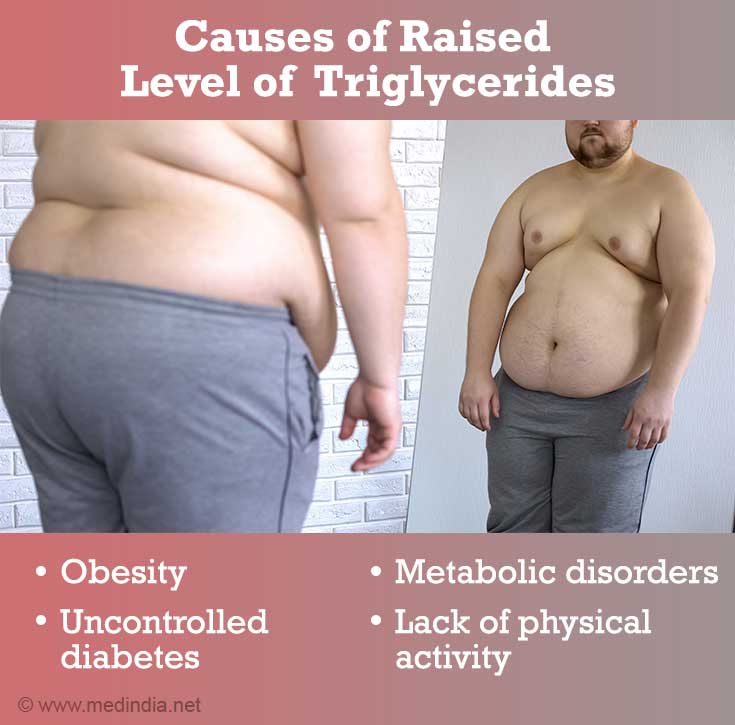- Triglycerides: Why do they matter? - (http://www.mayoclinic.com/health/triglycerides/cl00015)
- Hypertriglyceridemia - (http://emedicine.medscape.com/article/126568-overview#aw2aab6b2b2)
About
Triglycerides are a form of the fat that are obtained from the diet as well as synthesized by the liver.
What are Triglycerides?
Triglycerides are a form of the fat that are derived from vegetable and animal sources. The body also converts unused calories obtained from carbohydrates and proteins into triglycerides. These triglycerides are either used as an energy source or stored as fat in fat cells.
Triglycerides combine with particles called lipoproteins, which contain proteins and cholesterol. They form bad cholesterol, especially very-low-density lipoprotein (VLDL) and intermediate-density lipoprotein (IDL), which could give rise to heart disease. Hence, it is necessary to keep triglycerides levels within normal limits. The liver also converts unused calories from carbohydrates and proteins into triglycerides. Thus, it is necessary to keep the overall diet under control and limit the total calorie intake if you suffer from high triglyceride levels.
When the body requires energy from fatty acids, the hormone glucagon signals the breakdown of triglycerides. This releases free fatty acids, which can be utilized by the body.
High triglyceride levels, referred to as hypertriglyceridemia, often do not cause any symptoms until the levels reach 1000 to 2000 mg/dL. Hypertriglyceridemia could increase the risk of developing conditions like pancreatitis. It also increases the risk of heart disease in patients who also have high cholesterol levels.
Triglyceride Levels
A simple blood test taken after overnight fasting is used to determine triglyceride levels. Triglycerides are usually measured along with other blood lipids to obtain the lipid profile. Triglyceride levels may be classified as-
- Normal level - Below 150 mg/dL
- Borderline high triglyceride levels - 150 - 199 mg/dL
- High triglyceride levels - 200 - 499 mg/dL
- Very high triglyceride levels - 500mg/dL
The above values may vary slightly with different laboratories.
Causes and Risk factors of Hypertriglyceridemia
Hypertriglyceridemia has been associated with the following conditions
- Disease conditions such as uncontrolled diabetes, obesity, metabolic disorders, nephrotic syndrome, liver damage and hypothyroidism

- Genetic conditions such as abnormalities in the lipid metabolic pathways
- Patient factors such as age, race, sex and habits such as smoking, excess intake of sugars or alcohol and certain medications. Excessive alcohol intake has been particularly associated with hypertriglyceridemia.
- Pregnancy may result in a slight rise in triglyceride levels.
Common Symptoms and Signs of Hypertriglyceridemia
As mentioned above, hypertriglyceridemia does not cause symptoms until the levels are well beyond the normal limits. Some of the symptoms and signs of hypertriglyceridemia include:
- Pain in the upper middle abdomen, chest, or back, which may be associated with nausea and vomiting. The pain may be due to the development of acute pancreatitis or chylomicronemia syndrome, both of which are due to elevated triglyceride levels.
- Yellow-colored lesions may appear on the skin due to the accumulation of fats under the skin. These are referred to as xanthomas.
- A ring around the cornea may be formed due to lipid deposits. This is referred to as corneal arcus. Yellow plaques of fat deposits called xanthalesmas may appear around or inside eyelids. Changes in the retina may also be observed in patients with very high triglyceride levels.
Ways to Lower Triglyceride Levels
Some suggestions to reduce triglyceride levels in the blood are-
- Maintain your dietary intake of fat to 30 percent of the total calories. Choose a diet low in fats, specifically saturated fats. It is also necessary to reduce the intake of excessive calories from carbohydrates and proteins since the body can convert these into triglycerides.
- Eating small quantities of meals throughout the day instead of two large meals a day may benefit some individuals.

- Avoid sugars and refined foods that quickly add to the calories.
- Avoid alcohol and smoking.
- Exercise regularly and avoid a sedentary lifestyle. Regular exercise not only helps you to lose weight and burn calories, but it keeps you physically fit and gives a general feeling of wellbeing.
- Medication: Drugs like gemfibrozil and niacin are used to reduce elevated triglyceride levels. Omega-3-fatty acid derivatives and statins (atorvastatin, lovastatin, fluvastatin, etc.) are also used to lower the triglycerides.






